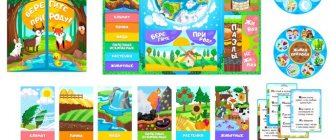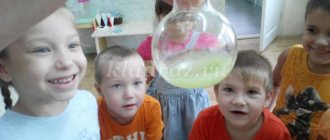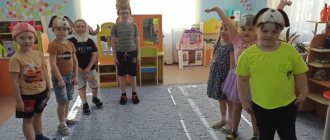Lesson “About volcanoes” for children
Experienced teachers have many ways to instill in a preschooler a love of science. These include working in a “children’s laboratory”, conducting scientific experiments, and simple experiments. By independently experimenting with substances and observing physical phenomena, children not only acquire knowledge about the world around them. They learn to think outside the box, exploratively, and can sometimes surprise with their logic.
One of the interesting topics about nature for children is volcanoes. The amazing world of these natural phenomena will not leave any child indifferent. And practical experience under the guidance of a teacher will delight even the most passive students.
Audience: preschoolers 5-6 years old
Props:
- Slides or posters about the structure of volcanoes, books about volcanoes for children, drawing sheets, pencils, markers, paints, brushes.
- Kit for conducting the experiment (basin or deep bowl, jar or bottle, water, cardboard, tape, soda, vinegar, dishwashing detergent, food coloring).
Progress of the lesson
The teacher begins the lesson with a riddle about a volcano:
-I throw stones, lava,
I am a dangerous giant!
Famous for its bad reputation.
What's my name? (Volcano)
- Children, today we will learn a lot of interesting things about volcanoes, what they are made of, how they sleep, erupt, and change the nature around them. In our laboratory we will conduct a magical experiment and see how lava flows out of a volcano, and at the end of the lesson we will have a quiz with questions about volcanoes. Do you love experiments and quizzes? At the end of the lesson, we will also play the game “Volcanologists”.
— What is a volcano? Maybe someone already knows?
This is a large natural mountain with a hole at the top from which hot streams pour out onto the surface of the earth.
— Where did the name Vulcan come from? The ancient people - the Romans - had a God of fire named Vulcan and he lived on the island of Vulcano in a country that is now called Italy. The god Vulcan commanded fire and lightning, and helped blacksmiths use fire to make objects from iron.
Here the teacher draws the attention of preschoolers to slides or posters about the structure of volcanoes.
—What does a volcano consist of? You and I already know that a volcano is a big mountain. It has a hole - a vent, from which hot, red-hot rock - lava - flows. The top of the vent is called a crater. It is located at the very top of the mountain. And below the mountain-volcano there is a huge cave with a hot substance called magma.
— Why do volcanoes erupt? Magma accumulates in the cave, begins to boil, rises up the vent and pours out onto the ground through the crater, turning into lava. Along with the magma, columns of smoke and volcanic ash erupt from the volcano, and hot stones fly. The whole earth around becomes gray and lifeless.
Physical exercise “Volcanic eruption”
- Let's imagine how a volcano erupts! Let's all sit on our haunches or on the floor. We are magma in an underground cave. Now let's start boiling and seething. We will splash our hands in the air and try to jump up. So the volcano is trembling, preparing to erupt. Now let our volcano burst out through the vent. Children jump up and raise their hands up. Magma poured out of the vent through the crater and spread over the ground, becoming lava.
Interesting facts about volcanoes
— And now interesting facts about volcanoes . They are active and dormant (extinct). Active volcanoes are those that have erupted in the last 10 thousand years and may still wake up and spew lava. Sleeping volcanoes will never wake up again. All volcanoes are studied by scientists - volcanologists; they are the ones who make predictions about what will happen next, whether the volcano will erupt or go dormant.
— The largest volcano on the planet, if you count the height from sea level, is Ojos del Salado . Its height is 6887 meters. It is located in South America and is considered dormant and extinct.
— The most dangerous volcano is located in Mexico, it is called Popocatepetl . Can you repeat this word? Volcanologists expect that he will someday wake up and erupt lava. Popocatepetl can kill a lot of people.
— In the Canary Islands there is a volcano on which a restaurant was built, and people cook food right on the fire of the volcano! They grill shish kebab and fish and treat the guests!
Now let's try to make a volcano erupt ourselves!
Children's laboratory experience
The teacher makes a model of the volcano in advance of the lesson or during the lesson with the children.
A basin or tray is placed on the table. This will be an island. The cardboard must be rolled into a cone and the seam sealed with tape or glue. The tip of the cone - cut off the crater with scissors. The cone can be coated with plasticine, so it will look like a real volcano. Place a bottle at the bottom of the basin under the cone, pour a tablespoon of soda into it, and pour in dishwashing detergent (25 ml). You can pour pebbles, sand into a basin around the mountain, and place animal figures. This way the picture will be more realistic.
In a mug, dilute food coloring (can be red or orange) with water and pour everything into a bottle under the volcano with the other ingredients. This way the magma will be ready.
And now the most important thing: pour vinegar into the mouth of the volcano and watch the eruption!
Here the teacher needs to be careful, it is important not to spill the vinegar and not allow the children to inhale this liquid.
Mixed with baking soda and dish soap in a bottle at the base of the volcano, the vinegar will create a rich foam from the volcano that will flow down the mountainside.
If you add baking soda and vinegar, the volcanic eruption can be repeated several times. Children will undoubtedly enjoy the spectacular experience.
After the experiment, it is advisable to ventilate the room.
Quiz
The quiz will help little researchers consolidate their acquired knowledge. Questions:
— Where did the name “volcano” come from?
— Which artisans did the god of fire help?
— What is the name of the hot substance in the cave under the volcano?
— What is the name of the long hole in a volcano through which magma rises?
- What is a crater?
— What does the magma that flows from the crater of a volcano turn into?
— What types of volcanoes are there?
—Who are volcanologists?
— What is the name of the largest volcano on the planet? Such a difficult word...
— What is the name of the most dangerous volcano?
Game "Volcanologists"
The most active participants in the quiz can be nominated as scientists - volcanologists. Let it be a girl and a boy.
Now you need to choose 3 - 4 strong boys who will firmly hold hands and form the mouth of a volcano. Their task is to hold their hands no matter what and not break the circle.
Volcanologists need to fill the volcano with magma. To do this, they call the rest of the participants into the mouth. A girl - a volcanologist - takes other girls by the hands and leads them into a circle - the mouth of a volcano. And the boy, a volcanologist, brings the boys, “pushing” them into the crater.
Circle - the muzzle stands firmly, without unclenching his hands. Children will have a lot of fun climbing into the circle and crowding around there; at this time the volcano is already seething, preparing to explode.
Everyone who did not fit into the crater can be called dinosaurs; they wander around the volcano. As soon as the vent overflowed, everyone who could entered the circle, the magma tore the vent - the volcano erupted, the children jumped out or fell out of the circle onto the floor. It's so fun!
Maybe now volcanologists themselves will choose an assistant and be the vent?
At the end of the lesson, the teacher invites the children to look at books about volcanoes for children with illustrations. Based on the knowledge they have acquired, children can themselves draw a volcano and the process of its eruption, using sheets of paper, paints, felt-tip pens, and pencils.
So, from the drawings in kindergarten, you will get an almost real scientific and educational exhibition about volcanoes for children.
Everything for a child's development
We offer an unforgettable experience for children, “Volcano Eruption,” which can be easily done with your own hands at home. The chemical experiment will be especially interesting for preschoolers and elementary school children.
You can purchase a ready-made set for the experiment (on Ozone: activate the discount code OZONBDJ91B, on My-shop.ru) or make a volcano from available materials that are found in every home. Let's consider two experiments.
Attention! All chemical experiments are carried out under the strict supervision of adults!
Salt dough volcano
Necessary materials:
- salt dough (recipe here);
- foil;
- plastic bottle;
- baking soda;
- vinegar;
- dishwashing liquid;
- food coloring (optional);
- a rimmed baking sheet or container.
How to do
Source: jugglingwithkids.com
Cut the plastic bottle in half.
Place the top of the bottle on a tray with the neck facing up. Cut strips of foil, wrap around the bottle and create a volcano shape.
Prepare the salt dough, roll it out, divide it into three parts and carefully place it on top of the foil.
For realism, color the volcano's mouth with red food coloring.
How to conduct an experiment
Pour two teaspoons of baking soda into the neck of the bottle and add a tablespoon of dish soap.
Pour vinegar into a glass and color with food coloring. Pour the liquid into the volcano and see thick colored foam flow from the crater. Children will be delighted by the spectacular volcanic eruption!
WE RECOMMEND
Colorful volcano made from soda and vinegar
Necessary materials:
- baking soda;
- vinegar;
- water;
- dishwashing liquid;
- liquid watercolor or diluted food coloring.
How to do
Source: funathomewithkids.com
To make a mixture for sculpting a volcano, take one cup of baking soda and mix with three tablespoons of water. To create a volcano like in the photo you will need 6 cups of soda. You can make the volcano smaller or larger.
Mix baking soda and water thoroughly and form a volcano. The correct mass for modeling should hold its shape well. Let dry for several hours.
Next, invite your child to color the volcano using a pipette and liquid watercolor.
How to conduct an experiment
Place the volcano in a container or other container with sides. Place a tablespoon of dish soap in the middle of the volcano and add a little vinegar. The reaction will not take long - thick foam will flow from the crater of the volcano with a hiss. An erupting volcano is a very exciting sight!
Books with experiences and experiments for children
(Click on the image for details).
SIMILAR ARTICLES:
- experiments,
- drawing
Form of organization: (group, subgroup, individual, pair). Educational and methodological set: Program “From birth to school” edited by N.E. Veraksa Goal: development of cognitive interests. Objectives: Cognition: - enrich the consciousness of children with new content that contributes to the accumulation of ideas about the world around them; - expand children’s understanding of objects and phenomena of inanimate nature; expand ideas about a natural phenomenon - a volcano. -develop activity, initiative and independence in the process of performing experiments.. Communication: -expand vocabulary based on the various ideas about the world that children develop, activate them in independent statements; - activate vocabulary in speech practice: lava, volcano, volcanologists, ash, dormant volcano, active volcano, extinct volcano, etc. Socialization: - cultivate interest and desire for creative knowledge of the world around us; - create a condition within the lesson for children’s independent cognitive activity. - support the child’s desire to actively interact with peers and adults; -to form equal, friendly relationships between peers; Health: - strengthen the health of children; -to develop experience in following safety rules when conducting physical experiments. Problem question: What is a volcano? Hypotheses: 1. A volcano is a fire-breathing mountain. 2. A volcano is an ordinary mountain. Equipment and materials: Screen, projector, laptop, computer presentation, pumice pieces, regular stones, bowls of water, balloons, mixture (baking soda, red gouache, dishwashing liquid), vinegar, parcel box, volcano models, material for drawings, drawings, tape recorder with audio recording of music. Preliminary work: -Reading the children's encyclopedia “Everything about everything” comp. O.I.Perfilyev. — Examination of illustrations depicting volcanoes. — Conversations about types of volcanoes. — Making a model of a volcano. The course of joint activities between an adult and children: 1. Relieving psycho-emotional stress. Guys, please come to me. Today many good and kind guests came to your kindergarten. Let's greet them and give them our sunny smiles. And now, we close our eyes and imagine, here and now we imagine ourselves. We forget what happened yesterday, We don’t know what will happen next. We only think about what is now. Good, beautiful, each of you, you are the best thing in the world. Open your eyes, hello children! 2. Motivation for activity. Guys, today the postman brought a parcel from children and teachers from the Skazka kindergarten. Let's open the package and see what's in it. (the parcel contains pumice and drawings) Guys, do you know what this is? The teacher gives the opportunity to look and touch the object. (Children’s answers) Listen to what the guys write: “Dear children! To guess why these items are in the parcel, you need to get acquainted with an amazing natural phenomenon. We have already met him. And with what phenomenon, listen and guess the riddle. He is huge, he is powerful, He is higher than the clouds. He can laugh with a bass voice, and spit fiery porridge. Good old giant - This is grandpa... (volcano) Yes, today our meeting is dedicated to such a mysterious, mysterious, amazing and formidable natural phenomenon as a “volcanic eruption”. 3. Organization of productive activities. Sit on the chairs in front of the monitor. (Showing a presentation about volcanoes “Fire-Breathing Mountains”) In some places on earth there are unusual mountains. (Slide No. 1, 2) When they “sleep” they differ little from other mountains. But as soon as they wake up, flames and hot stones burst out of their peaks (the volcano’s mouth). Volcanoes are shrouded in smoke, explosions sound, hot liquid flows down the slopes - lava, a real fiery stream. Volcanoes erupt. The volcano wanted to sneeze - the pressure rose. The lava was on its way through the vent and set out on an adventure. It swept up the vent, broke through, and spilled out of the holes with a noise and a crash! Oh God! Guys, you know, volcanoes are active, dormant and extinct. (Slide No. 3) Active volcano - when a volcanic eruption occurs. (Slide No. 4) During an eruption, the volcano looks like a raging beast. He growls and bites, and can cause a lot of trouble. Which volcano do you think is called dormant? (Children's answers) Sleeping is a volcano that looks like an ordinary mountain, but can explode with fiery lava at any moment. (Slide No. 5) The volcano sleeps, only occasionally smokes, exhales light smoke into the sky, as if someone is lighting a stove. And a volcano is really an oven, only underground. There is a fire raging inside her all the time. Dormant volcanoes are gathering strength to awaken. Which volcanoes are called extinct? (Children's answers) These are the volcanoes that worked in the distant, distant past. (Slide No. Guys, do you know why fire-breathing mountains are called “volcanoes”? (Children’s answers) Physical education minute. Warm-up begins. We stood up, straightened our backs. Bent to the right and left. And repeated again. (Bends to the sides.) We squat counting, One, two, three, four, five. This is the necessary work - Train the leg muscles. (Squats.) And now we perform arm jerks with you. (Arm jerks in front of the chest). Listen to an interesting legend (calm music sounds). " There lived in Ancient Rome a god named Vulcan and he liked blacksmithing - standing at an anvil, hitting iron with a heavy hammer, fanning the fire in the forge. He built himself a blacksmith inside a tall mountain. When Vulcan worked with a hammer, the mountain trembled from top to base, and the roar and roar spread far around. From the hole in the mountain, hot stones, fire and ashes flew with a deafening roar. “The volcano is working!” - people said with fear and went to live away from this place." Now, guys, we know that the volcano is so named after God, who liked blacksmithing. Did you like the legend? Was it interesting? What does the legend say? Fine! Well done! Look at the shape of the volcano, what does it look like? Children: Looks like a pyramid, a cone. Educator: That's right, guys, the volcano is cone-shaped. Pay attention to its upper part, what does it look like? Children: To a large hole, a funnel. Educator: That's right. Who knows what this part of the volcano is called? Educator: The top of the mountain from which a volcano erupts is called a volcanic crater. The crater of the volcano is a huge bowl with steep slopes, and at the bottom there is a reddish-orange mouth - this is a vent, a hole that goes deep into the ground. The fiery liquid coming out of a volcano is called lava. And now you can watch the volcano erupt. Presentation of video material with sound “Volcanic eruption” Higher than the clouds, Volcanoes rise, Majestic and mighty, Like giants in a fairy tale. 4. Independent activity. Guys, I suggest using experience to find out why a volcano erupts in the first place. Let's go to the young researcher's corner. (Children go to the tables for experiments) Experiment 1. Guys, do you remember about the parcel. What was there? (Answers) Guys, I’ll tell you an amazing fact now. When lava comes out of a volcano, it cools and hardens when exposed to air. Pieces of solidified lava are the pumice that was in our package. Let's look at stones of volcanic origin - pumice and ordinary stones. Look carefully at the stones and pumice. What is the difference? (Answers) There are many holes in the pumice stone. Are the holes empty or is there something in them? (Answers) Air is hidden in the holes, which is why pumice is lighter than ordinary stone. How can this be checked? (Children's answers) I suggest putting pumice and ordinary stones into the water. (Do the experiment) What discovery did we make? (Children's answers) Pumice is a stone in which there are many holes in which air accumulates. Pumice does not sink. There are indeed air bubbles inside the pumice. This is because the lava boiled and seethed, and then froze. Finger game “Spider” (Hands are crossed. The fingers of each hand “run” along the forearm, and then along the shoulder of the other hand.) The spider walked along the branch, and the children followed him. (The hands are freely lowered, we perform a shaking movement - rain.) Rain suddenly poured from the sky, (Clapping of palms on the table/knees.) The spiders were washed to the ground. (The sides of our palms are pressed to each other, our fingers are spread out, we shake our hands - the sun is shining.) The sun began to warm up, (We make the same movements as at the very beginning.) The spider crawls again, (“Spiders” crawl on the head.) And All the children crawl after him to take a walk on the branch. Experience 2. Guys, now I suggest you turn into wizards and try to awaken a volcano. Do you think we can do it? (Answers) (Approach the model of the volcano) Our volcano is sleeping for now, but we will wake it up. The game of volcano lords has begun! We pour a mixture inside the “volcano” (the teacher performs the experiment himself, the children follow the teacher’s actions): baking soda mixed with red gouache and dishwashing liquid. And then... Carefully pour the vinegar slightly diluted with water (only adults can do this) into the “volcano”. And our volcano woke up! Volcanoes began to “volcano” - spew lava from their craters. Lava flowed down the slopes and severely burned the Earth. Centuries later, the evil Vulcan coughed up both ash and ash. The volcano is thundering! The volcano is chugging! How menacing he looks now! But then he began to get tired - the Fire in him began to fade. He breathed fire for the last time - And fell asleep for decades. Centuries will pass... And again the volcano will wake up, And lava will flow from its interior. And our volcano can wake up and fall asleep whenever we want. 5. Guys, I have an unusual task for you. Children from another kindergarten have prepared a riddle for you. They started drawing active volcanoes, but did not finish their drawings. They offer you to finish drawing. Do you agree to finish the drawings? (Children's answers) I invite you to a creative workshop. Choose your drawings, sit down at the tables and finish drawing the volcanoes. (Music plays, children draw) I suggest you organize an exhibition “Unknown Planet” in the evening. Volcanoes." 6. Summing up Guys, did you like our meeting? (Answers) What do you remember most? (Answers) Guys, if you are interested in volcanoes, in children's encyclopedias, together with your teacher, you can read what profession people study volcanoes, how they study them in order to warn people about a possible volcanic eruption. You can also learn about the children of volcanoes - geysers! Thanks everyone for your work! You are very capable and wonderful! 7. Surprise moment And now there’s a surprise for you! I have a volcano that does not spew out stones, lava, ash, but spews out sweet gifts. (Candies in red candy wrappers are taken from the crater of the model) Used literature: 1. Tugusheva G.P., Chistyakova A.E. Experimental activities of children of middle and senior preschool age: Methodological manual. - SPb.: CHILDHOOD - PRESS, 2010. 2. Dietrich A., Yurmin G. Pochemuchka. M.: Pedagogy - Press, 1997. 3. Fire-breathing torches of Kamchatka // Preschool education, No. 12/2010. 4. Volcanic eruption //Preschool education, No. 1/2011. 5. Geysers - children of volcanoes // Preschool education, No. 10/2011. 6. Internet resources.




